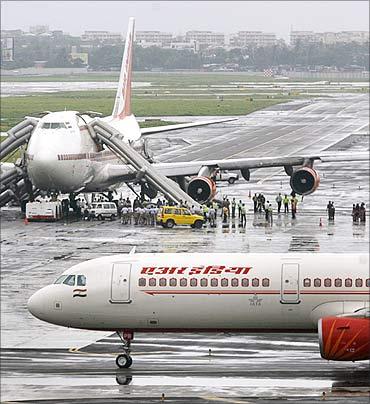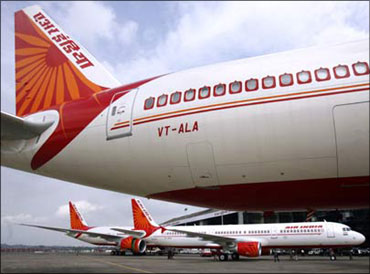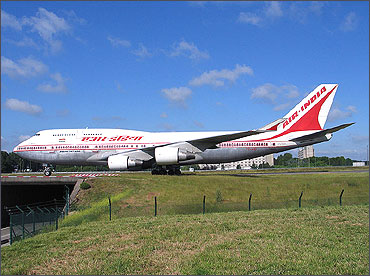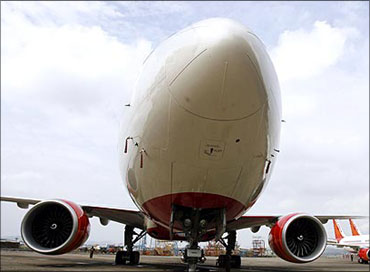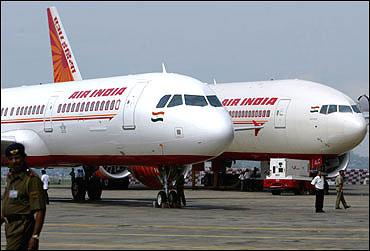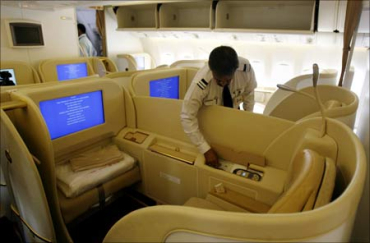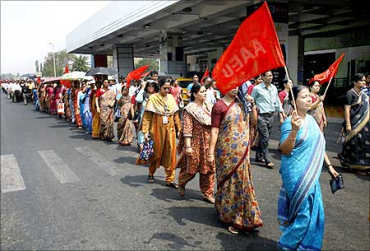The story of Air India's slow death
Last updated on: September 15, 2011 09:45 IST
Of the scandals that have visited the United Progressive Alliance government lately, perhaps the most damaging is the report by the Comptroller and Auditor General (CAG) on the way state-owned Air India has been run into the ground.
Damaging, not because of the actual financial loss but because it exposes the system.
In popular perception, the villain of the piece is former civil aviation minister Praful Patel. But as he has pointed out, and as the chronology of events in the report shows, they were all in it together.
Click NEXT to read more
The story of Air India's slow death
Last updated on: September 15, 2011 09:45 IST
The ministry's proposals for fleet acquisition and merger of Air India and Indian Airlines went through several filters: the Planning Commission, Public Investment Board, committee of secretaries, group of ministers and the Cabinet.
The prime minister was fully in the picture and doubts and objections raised at some levels were subsequently given up while recommending sanction.
The report also belies the oft-repeated point that CAG is overstepping its brief in policy area.
Click NEXT to read more
The story of Air India's slow death
Last updated on: September 15, 2011 09:45 IST
It does not, for example, question the wisdom of large purchase of planes after many years (in fact, it supports the action) and merging the two airlines, but asks whether these were adequately planned and put through with economy and efficiency.
In assessing the impact of the new bilaterals, it examines the oversight exercised by the ministry. Overall, it questions the reliability of data and reasonableness of assumptions used in decision making, as well as the adequacy of facts put up before the approving agencies.
In fact, CAG seems to have done a creditable job and, as any CEO who has read the report would tell you, has adopted a business approach.
Click NEXT to read more
The story of Air India's slow death
Last updated on: September 15, 2011 09:45 IST
A concept paper prepared by A T Kearney in 2004 on the potential for value creation through collaboration between the two airlines on fleet and networks was not considered when fleet acquisitions were made for the two airlines independently.
But in March 2006, a few months after the independent fleet acquisitions by the two airlines, the government gave "in principle" approval for the merger.
The report has argued that merger before the aircraft acquisition could have altered the acquisition strategy. Also, the government failed to implement the merger as envisaged. The exercise was "ill timed with loss of significant synergistic opportunities".
Click NEXT to read more
The story of Air India's slow death
Last updated on: September 15, 2011 09:45 IST
The main financial case for the merger "was not adequately validated, prior to the merger".
Except for a statement by Accenture, appointed consultant for the merger, that profitability would rise by over Rs 600 crore (Rs 820 crore benefits minus Rs 200 crore costs) or four per cent of current combined yearly revenue, there was no "detailed item-wise financial analysis" so as to "assess the reasonableness and robustness of these projected savings".
The initial estimate of synergy benefits of Rs 820 crore (Rs 8.2 billion) was later revised to Rs 996 crore (Rs 9.96 billion).
The story of Air India's slow death
Last updated on: September 15, 2011 09:45 IST
But after claiming to have achieved Rs 503 crore by December 2008, the Air India management said further quantification of benefits was difficult because they were the cumulative effects of many factors.
Also, there were huge delays in integrating operations after the formal merger. The process remains incomplete after four years.
Integrating the two networks and reservation systems to operate through a single code, aimed at facilitating seamless travel across domestic and international routes, was delayed considerably.
Click NEXT to read more
The story of Air India's slow death
Last updated on: September 15, 2011 09:45 IST
The single code started operating only early this year. Mainly as a result of this delay, Star Alliance has put Air India's membership on hold. The ministry has told the CAG that it came to know of the Star Alliance decision "from news reports"!
The biggest flaw in the merger process has been the inability to satisfactorily integrate the human resources of the two organisations. This remains incomplete for 98 per cent of employees.
Matters like pay and allowances, promotion, seniority and transfer remain unresolved, even though nobody is in danger of losing his job or getting lower pay and allowances.
Click NEXT to read more
The story of Air India's slow death
Last updated on: September 15, 2011 09:45 IST
Even after four years of merger, the two arms have separate accounting packages and it was only early this year that work on implementing a common enterprise resource planning (ERP) solution, the sine qua non of a single business, began.
Even here, the report doubts whether targeted completion by March 2013 will be achieved. This seems legitimate, considering how long ERP implementation takes and the airline's management culture.
The only area where the merged airline seems to have fared well is route rationalisation and integration of networks - the report acknowledges this.
Click NEXT to read more
The story of Air India's slow death
Last updated on: September 15, 2011 09:45 IST
Perhaps the most serious indictment of Mr Patel is contained in the report's comments on how Air India has been forced to play on a non-level playing field and, thus, has had to give up potential lucrative business in the Gulf and elsewhere through generous bilaterals executed under India's version of open skies.
This has allowed airlines like Emirates with huge hubs (something India is only now getting through terminals like T3 in Delhi) to eat into the traffic from all over India to Europe and North America.
Click NEXT to read more
The story of Air India's slow death
Last updated on: September 15, 2011 09:45 IST
Ironically, the ministry under Mr Patel justified the vast expansion of entitlements under bilaterals so as to help Indian workers go to West Asia when the actual requirement on that score was far lower.
"It is certainly not our case that AI should benefit from a protected environment, cloistered from competition from foreign airlines (and other Indian carriers), especially in the current era of economic liberalisation. However, the timing of the liberalisation of bilateral entitlements (notably the Gulf/ SE Asia/ Europe) from 2004-05 onwards left much to be desired."
As auditor speak goes, that is pretty damning.
Source:


